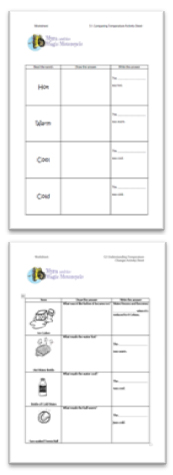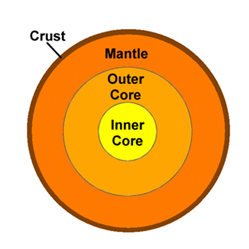Science School Activities for Foundation to Year2
Inside the Earth—Discussion Questions
Skills: listening | comprehension | earth science | science inquiry skills
Level: foundation–year2
Materials
Teacher Instructions
Read
Myra Book 1at least pages 3–17 to your student(s). You will have time during an activity further down to read the rest of the story while waiting for some items to change temperature.
You can then do the following activity either as a group activity or discussion, or get each student to write down their own answers.
Discussion
- Myra and Diver did something magical on page 15. What was it?(Ans: the magic motorcycle went through the Earth)
- How did it feel inside the Earth? (Ans: warm) ADVANCED: Why? (Ans: There could be a range of possible answers here, such as "Because it’s warmer inside the Earth", "Because they are no longer exposed to the cold air outside" etc.)
- Was it light or dark inside the Earth? (Ans: dark)Why? (Ans: because the sun cannot reach them inside the ground.)
- What strange shapes were seen in the picture on page 15? (Ans: treasure chest, dinosaur skeleton)Can people really find things like this under the ground? (Ans: yes). ADVANCED: How did they get there? (Ans: Somebody buried the treasure, the dinosaur died long ago and its body was covered in layers of silty water and the bones fossilized).
- When they were inside the Earth, Myra and the Magic Motorcycle "hurtled through layers of …" what? (Ans: rock and magma, p.16)
- What was at the centre of the Earth? (Ans: the core, or the "white-hot scorching core", p.16)
- What happened after they passed through the core? (Ans: they continued through the other half of the Earth and came out on the other side.)
- Where did they start their journey? (Ans: Limestone Point, Australia). Where did they end up? (Ans: Bermuda, or on the other side of the world)
Next read page 44 For curious minds: Learn about Globe Slide and the Earth
- What button did Myra push to go through the Earth? (Ans: Globe Slide) ADVANCED: Why do you think the author called it this? (Ans: This is an open-ended question, they might say because it’s like the motorcycle is sliding down through the layers of rock, or it’s sliding in another dimension, or similar)
- Is the Earth shaped like a ball, an egg or a dinner plate? (Ans: a ball)
- What is spread over the surface of the Earth? (Ans: the oceans and the land)
- What is roughly opposite Australia, on the other side of the Earth? (Ans: Bermuda)
- Can people really travel through the middle of Earth, like Myra did? (Ans: No.) ADVANCED: Why? (Ans: we don’t have a magic motorcycle, we don’t have any vehicles that can go through the Earth, it’s too hot, it’s too difficult to build a road through the earth, etc.)
- What is magma?
- A yummy chocolate ice cream
- Lava
- A type of car
- Melted rock
- Solid rock
- What is the temperature like at the Earth’s core?
- 40,000 degrees Celsius
- 4,000 degrees Celsius
- 2,000 degrees Celsius
Craft Activity—Earth’s Core
Materials
- A sheet of white A4 paper
- Yellow, light orange, dark orange, red and brown coloured paper
- Pens, pencils, crayons
- A compass, a milo tin or a bucket (etc.)
- Magazines with images like buildings, people, trees etc.
Instructions: Option 1 White Paper Only
- Draw a large circle using a compass or the bottom of a milo tin or bucket
- Pretend you are looking at half of the Earth, like you have sliced a ball in half. Draw two smaller circlesand label the layers "Crust", "Mantle", "Outer Core" and "Inner Core".
- Colour them in.
- Get creative. Put anything you like inside or outside your picture of earth. You might like to cut and paste some volcano shapes above the surface of the Earth from brown paper, or make lava ducts out of red or orange paper below the surface. You might like to add cities, houses, trees, aeroplanes or people to the surface, or dinosaur bones and treasure chests under the ground.
- Magazines with images like buildings, people, trees etc.
Instructions: Option 2 Coloured Paper
- Pretend you are looking at half of the Earth, like you have sliced a ball in half.
- Draw a large circle on the brown paper using a compass or the bottom of a milo tin or bucket and cut it out
- Draw a slightly smaller circle on the dark orange paper and cut out.
- Draw a smaller circle on the light orange paper and cut out.
- Draw a much smaller circle on the yellow paper and cut out.
- Stick the yellow in the centre of the light orange, then this in the centre of the dark orange, then this in the centre of the brown.
- Label the layers "Crust", "Mantle", "Outer Core" and "Inner Core".
- Get creative. Put anything you like inside or outside your picture of earth. You might like to cut and paste some volcano shapes above the surface of the Earth from brown paper, or make lava ducts out of red or orange paper below the surface. You might like to add cities, houses, trees, aeroplanes or people to the surface, or dinosaur bones and treasure chests under the ground.
Download this activity as a PDF you can print out
Comparing Temperature Activity
Skills: observation | earth science | science inquiry skills
Level: foundation–year 2
Materials
- 1 x black permanent marker per child or group
- 1 x print out of the "S1: Comparing Temperature Activity Sheet" for each child
- 1 x print out of the "S2: Understanding Temperature Changes Activity Sheet"
- 1 x tennis ball per child
- 1 x ice cube tray per child (or bag of ice from a service station)
- 1 x small plastic bottle per child (eg. a disposable juice pop top container)
- 1 x place mat and tea towel per child
- (Optional: check school safety regulations) 1 x hot water bottle per child.
- Cold water
- Hot water jug
- Refrigerator or ice box
Teacher Instructions
You may need the assistance of your teacher aide for this one. It will need to be a warm sunny day or alternatively, do you have access to a safe means of heating up a tennis ball slightly (eg. place in front of a heater).
- Each child to have a place mat and tea towel on the desk in front of them.
- Ask each child to write their name on their ball and bottle (retrieve the pens right away so they’re not tempted to graffiti in permanent ink anywhere)
- Ask each child to place their bottle of water in the refrigerator or ice box, and their tennis ball outside in the sunshine, or in front of the heater.
- If you haven’t already read the rest of Myra Book 1 (pages 18+) go ahead and do so. After about ten minutes, proceed:
- Each child can retrieve their bottle and tennis ball.
- Give them each an ice cube tray full of ice cubes and a tightly sealed hot water bottle filled with not quite boiling hot water, ensure it is not hot enough to burn in case of an accident.
- Instruct the students as follows:
"With the three (or four) things on your desk feel the difference in temperature."
ADVANCED: "Are the things in different states, like liquid or solid? Observe how the things are changing in temperature."
 Allow the students some time to manipulate the objects.
Allow the students some time to manipulate the objects.
"Move the things into sequence of coldest to hottest."
Pack up the things now, get the students to dry the desk so they can write on the sheets. Hand out the sheets. Discuss/instruct:
"Which item was the coldest? Which one was the hottest? Complete the worksheet S1—Comparing Temperature Activity Sheet . Read the words. Draw the answer. Write the answer."
Answers: hot water bottle; tennis ball; water bottle; ice
Advanced students may be able to do the next worksheet while they are waiting for the rest. Use S2—Understanding Temperature Changes Activity Sheet. Discuss/instruct:
"What made each item change temperature? What was it like before? What was it like after the activity?
Complete the worksheet S2—Understanding Temperature Changes Activity Sheet . Look at the pictures. Read the questions. Draw the answer. Write the answer."
Answers: DRAWINGS: water; jug; refrigerator/ice box; sun/heater.
WRITTEN: solid; liquid, solid, gas/steam; warmer; cooler

 Allow the students some time to manipulate the objects.
Allow the students some time to manipulate the objects.